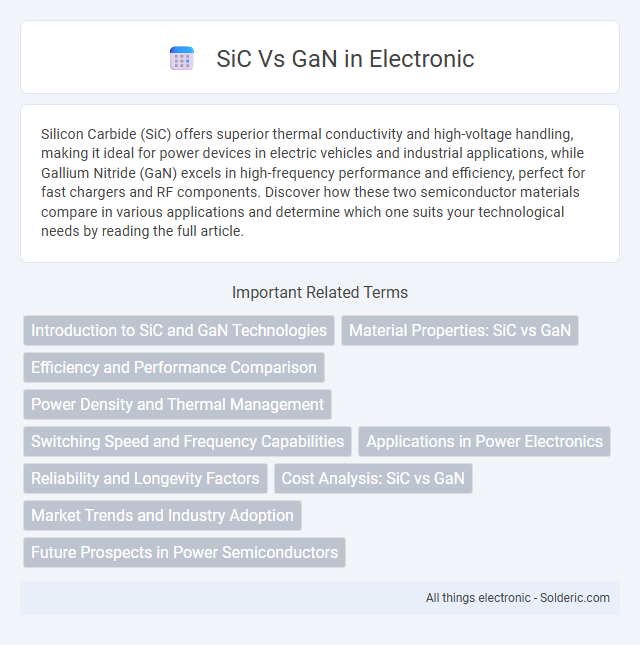Silicon Carbide (SiC) offers superior thermal conductivity and high-voltage handling, making it ideal for power devices in electric vehicles and industrial applications, while Gallium Nitride (GaN) excels in high-frequency performance and efficiency, perfect for fast chargers and RF components. Discover how these two semiconductor materials compare in various applications and determine which one suits your technological needs by reading the full article.
Comparison Table
| Feature | Silicon Carbide (SiC) | Gallium Nitride (GaN) |
|---|---|---|
| Material Type | Wide bandgap semiconductor | Wide bandgap semiconductor |
| Bandgap Energy | ~3.26 eV | ~3.4 eV |
| Maximum Operating Temperature | Up to 600degC | Up to 350degC |
| Electron Mobility | 900 cm2/V*s | 2000 cm2/V*s |
| Breakdown Electric Field | ~3 MV/cm | ~3.3 MV/cm |
| Switching Speed | Moderate | Very High |
| Power Efficiency | High | Very High |
| Applications | High-voltage power devices, EVs, industrial inverters | RF amplifiers, fast chargers, data centers |
| Cost | Higher due to substrate manufacturing | Lower, easier substrate integration |
Introduction to SiC and GaN Technologies
Silicon Carbide (SiC) and Gallium Nitride (GaN) are advanced semiconductor materials revolutionizing power electronics with superior efficiency and thermal performance compared to traditional silicon. SiC excels in high-voltage, high-temperature applications due to its wide bandgap and high breakdown electric field, making it ideal for electric vehicles and industrial power systems. GaN offers fast switching speeds and high electron mobility, which enhances performance in RF components, fast chargers, and 5G technology infrastructure.
Material Properties: SiC vs GaN
Silicon Carbide (SiC) offers superior thermal conductivity, wide bandgap energy of about 3.26 eV, and high breakdown electric field, making it ideal for high-power and high-temperature applications. Gallium Nitride (GaN) features a slightly wider bandgap of approximately 3.4 eV and exhibits higher electron mobility, enabling faster switching speeds and higher frequency operation. SiC's mechanical robustness contrasts with GaN's efficiency in high-frequency power electronics, defining their distinct roles in semiconductor devices.
Efficiency and Performance Comparison
Silicon Carbide (SiC) devices offer higher voltage tolerance and superior thermal conductivity, enabling efficiency rates of up to 99% in high-power applications. Gallium Nitride (GaN) transistors excel in high-frequency switching and exhibit lower on-resistance, which results in faster switching speeds and reduced energy losses. GaN's performance advantages are particularly significant in compact, low-voltage systems, while SiC dominates in high-power, high-temperature environments.
Power Density and Thermal Management
SiC (Silicon Carbide) devices offer higher power density compared to GaN (Gallium Nitride) due to their ability to operate at higher voltages and temperatures, which enables more compact and efficient power systems. Thermal management in SiC is more straightforward because of its superior thermal conductivity, allowing better heat dissipation and reducing the need for complex cooling solutions. Your choice between SiC and GaN should consider these factors to optimize performance in applications demanding high power density and effective thermal control.
Switching Speed and Frequency Capabilities
Silicon Carbide (SiC) semiconductors offer impressive switching speeds with low switching losses, making them suitable for high-voltage and high-power applications. Gallium Nitride (GaN) excels in ultra-fast switching frequencies, enabling devices to operate efficiently at frequencies above 1 MHz, which is ideal for compact and high-frequency power converters. Choosing between SiC and GaN depends on your specific application requirements, such as the need for higher voltage handling or ultra-high-speed switching.
Applications in Power Electronics
Silicon carbide (SiC) and gallium nitride (GaN) are revolutionizing power electronics by offering superior efficiency and thermal performance compared to traditional silicon devices. SiC is predominantly used in high-voltage applications such as electric vehicles, renewable energy systems, and industrial motor drives due to its robustness and ability to handle high power levels. GaN excels in lower voltage, high-frequency applications like power adapters, data centers, and RF amplifiers, enabling your devices to operate with reduced energy loss and enhanced switching speeds.
Reliability and Longevity Factors
Silicon Carbide (SiC) devices exhibit superior reliability due to their higher thermal conductivity and lower defect density, which contribute to enhanced longevity under high-temperature and high-voltage conditions. Gallium Nitride (GaN) offers excellent performance at higher switching frequencies but typically demonstrates lower robustness in harsh environments compared to SiC, affecting its long-term durability. Both wide bandgap semiconductors improve device lifespan relative to silicon, yet SiC's established maturity in power applications makes it the preferred choice where reliability and longevity are critical.
Cost Analysis: SiC vs GaN
Silicon Carbide (SiC) devices typically have higher initial production costs compared to Gallium Nitride (GaN) due to more complex manufacturing processes and material expenses. GaN technology offers lower fabrication costs and smaller device sizes, which reduce overall system expenses, especially in high-frequency applications. Your choice between SiC and GaN should consider total cost of ownership, including efficiency gains, thermal management, and application-specific performance benefits.
Market Trends and Industry Adoption
Silicon Carbide (SiC) and Gallium Nitride (GaN) are driving rapid growth in the power electronics market, with SiC gaining traction in high-power applications such as electric vehicles and renewable energy systems due to its superior thermal conductivity and voltage capabilities. GaN is increasingly adopted for high-frequency, low-power applications like fast chargers and RF devices, benefiting from its efficiency and compact size. Your choice between SiC and GaN will depend on the specific industry's demand trends and performance requirements, as both materials are critical in advancing energy-efficient technologies.
Future Prospects in Power Semiconductors
SiC (Silicon Carbide) and GaN (Gallium Nitride) are poised to revolutionize power semiconductors with their superior efficiency and high-temperature performance, critical for electric vehicles and renewable energy systems. SiC's robust thermal conductivity and voltage tolerance make it ideal for high-power applications, while GaN's fast switching speeds and low on-resistance favor compact, high-frequency devices in consumer electronics. Continued advancements in material quality and manufacturing processes are expected to drive cost reductions, enabling widespread adoption across automotive, industrial, and telecommunications sectors.
SiC vs GaN Infographic

 solderic.com
solderic.com